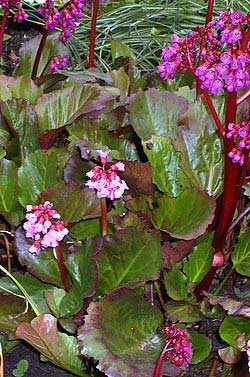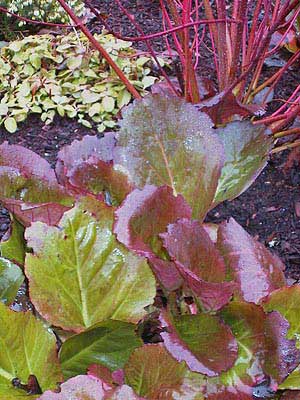Bergenia cordifolia
HEARTLEAF BERGENIA
Family: Saxifragaceae
Pronounced: ber-GEN-ee-ah kor-di-FO-lee-ah
Quick Jumps
Growing Guide
Rainy Side Notes
GROWING GUIDE

Origin:
Siberia.
Plant Group:
Perennial.
Hardiness:
Sunset zones: 1-9, 12-24.
USDA zones: 3-8.
Mature size:
Height: 24 inches (60 cm).
Width: 30 inches (75 cm).
Flowering period:
Late winter to early spring.
Flowering attributes:
Rose-colored flowers in clusters on top of stem, sometimes hidden in the leaves.
Leaf attributes:
Glossy, heart-shaped, evergreen leaves turning burgundy tints in winter.
Growth habit:
Clump-forming.
Light:
Partial shade or full sun in our maritime climate.
Soil:
Any soils, but will grow best in humus rich soil.
Feeding:
I found the best results with side dressing with compost and manures with a spring feeding of a complete organic fertilizer.
Propagation Methods:
Divide in spring or fall. | Sow seed in spring 72-75ºF (22-24ºC). Do not cover seed.
Pruning Methods:
Prune out old leaves. I prefer to do this in winter and anytime when needed.
Pests and Diseases:
Slugs are a problem as they disfigure the foliage.
Rainy Side Notes

The genus, Bergenia, was named after the German botanist, Karl August von Bergen, who lived in the 18th century. Cordifolia means heart-shaped leaves.
Here in the Pacific Northwest, bergenias tolerate full sun. Their large, evergreen leaves are what I most enjoy about this species. They look good planted in large drifts with lacy-looking ferns intermingled. Bergenia is an excellent plant to grow with many small evergreens and small-leaf ground covers, which provide good foliage effect all year round.
When clumps are getting crowded, I divide them. This plant is very easy to start from seed. Slugs can be a problem when seedlings are small. Although it is recommended to feed regularly, I find that too much new growth makes the plant too attractive to slugs. This is why I give it one feeding in spring and use side dressings of compost or manure.
Alan Armitage remarks, "If you rub the leaf between thumb and forefinger just right, it sounds like a pig squeaking." Wow! The things we learn in horticultural circles.
Photographed in author's garden.

Gardening for the Homebrewer: Grow and Process Plants for Making Beer, Wine, Gruit, Cider, Perry, and More
By co-authors Debbie Teashon (Rainy Side Gardeners) and Wendy Tweton
Copyright Notice | Home | Search | Perennials

